Full color ghost imaging by using both time and code division multiplexing technologies
Le Wang(王乐) Hui Guo(郭辉) and Shengmei Zhao(赵生妹)
1Institute of Signal Processing and Transmission,Nanjing University of Posts and Telecommunications(NUPT),Nanjing 210003,China
2College of Information Engineering,Fuyang Normal University,Fuyang 236037,China
We propose a new full color ghost imaging scheme using both time and code division multiplexing technologies. In the scheme, the speckle patterns of three colors (red, green and blue) are modulated with different time slots and codes.The light intensity is sampled by one bucket detector. Then based on the modulated time slots and codes,we can effectively and simultaneously extract three detection component signals corresponding to three color components of objects from the sampling signal of the bucket detector. Finally,three component images resulting from the three component detection signals can be synthesized into a full color image. The experimental results verify the feasibility of our scheme under the limit of the number of time slots and codes. Moreover,our scheme reduces the number of bucket detectors and can realize high quality imaging even in a noisy environment.
Keywords: ghost imaging,time division multiplexing,code division multiplexing,full color imaging
1. Introduction
Ghost imaging(GI)is considered as an outstanding optical imaging technology,[1]which can image objects by correlating the speckle patterns with their bucket detection signals.GI was realized based on the quantum properties of entangled photon pairs by experiments in 1995.[1]Since then,GI has received considerable attention because it can be extended to the thermal light field[2–5]and has great advantages for robustness against harsh environment,[6–9]high spatial resolution[10–12]and more applications[13–16]compared to the traditional imaging technology.
Recently, constructing a full color GI scheme turns into a hot research area.[17–25]Most studies[17–19]of the full color GI have been based on use of three spectrally filtered bucket detectors, which can obtain three detection component signals corresponding to three color(red,green and blue)components of objects. Then three component images resulting from three detection component signals can be synthesized into a full color image. However,the cost of this method is high because it uses more bucket detectors than monochromatic GI,which limits its practical applications. Another method[20–25]of full color GI is based on time division multiplexing(TDM)technology (named FCGI-TDM), where the whole sampling time is divided into three recurrent time slots of fixed length,and the specific colored speckle pattern is allotted a time slot on a round-robin basis. Then three component images resulting from three time slots can be synthesized into a full color image. Hence, FCGI-TDM has the benefit of decreasing the number of bucket detectors. However, FCGI-TDM suffers from the ambient light intensity fluctuations, which degrades the imaging quality.[26]
In addition,a new full color GI with multiple input single output (MISO) technology (named FCGI-MISO)[27]is proposed to use one bucket detector to simultaneously measure three detection component signals from the speckle patterns modulated by the cosine waveforms with the specific frequency. From the perspective of code division multiplexing(CDM)technology,[28,29]the cosine waveform modulated into speckle patterns can also be regarded as a special form of modulating code. Finally,three component images resulting from three detection component signals can be synthesized into a full color image. The benefits of FCGI-MISO are that it not only requires one bucket detector to sample three component images, but also is not affected by the fluctuation of ambient light intensity. However, the realization of FCGI-MISO is limited by the number of cosine waveforms with specific frequency,especially when FCGI-MISO is extended to hyperspectral GI.
In this paper, we propose a full color GI scheme using both TDM and MISO technologies, where the speckle patterns of three colors are modulated with two time slots and two cosine waveforms of different frequencies. Because the cosine waveform modulated into speckle patterns is regarded as a special form of modulating code of CDM,our scheme can be referred to a full color GI scheme by using both TDM and CDM technologies, named FCGI-TCDM. The advantages of FCGI-TCDM are stated in the following. Firstly,it can image the object under the limit of the number of time slots and codes because FCGI-TDM with only two time slots cannot realize full color imaging and FCGI-MISO cannot also achieve full color imaging by using only two cosine waveforms with different frequencies,however,FCGI-TCDM can achieve full color imaging by using two time slots and two cosine waveforms with different frequencies. Secondly, FCGI-TCDM can realize high quality imaging even in a noisy environment with the fluctuation of ambient light intensity. Thirdly, FCGI-TCDM reduces the number of detectors because of the requirement of only one bucket detector.In addition,FCGI-TCDM can be extended to some ghost imaging fields with one bucket detector,such as multispectral GI and polarized GI.
The organization of the paper is as follows. Section 2 presents the proposed scheme. Section 3 shows the experimental results of our scheme. Finally,we give conclusions in Section 4.
2. Scheme description
Figure 1 shows the schematic diagram of FCGI-TCDM.Three light sources with specific color in FCGI-TCDM respectively generate a uniform light field with a temporal waveform modulated by different time slots and cosine waveforms of different frequencies. Here we use two time slots (0<t <T/2 andT/2<t <T)and two cosine waveforms with frequenciesf1andf2to realize FCGI-TCDM, whereTis the time slot duration of each speckle pattern. Therefore, speckle patterns with at most four colors can be produced in FCGI-TCDM.However, because only three colored speckle patterns are required in a full color GI, we inevitably reuse one color to represent two speckle patterns. Hence, in the first time slot 0<t <T/2, the light from red and green sources are modulated with two cosine waveforms with frequenciesf1andf2,respectively. In the second time slotT/2<t <T, the light from green and blue sources are modulated respectively with two cosine waveforms with frequenciesf1andf2. Subsequently the superposed light is modulated by a digital micromirror device(DMD)to generate a speckle pattern.Therefore,themth speckle patternSm(x,y,t)is

withIm(x,y) being the spatial speckle pattern. In this paper,we use the Walsh–Hadamard speckle patterns[5]forIm(x,y).Here,ais the direct current offset of the cosine waveform;bis the cosine waveform’s amplitude;m=1,2,...,M;Mdenotes the number of speckle patterns;irepresents the frequency of the cosine waveforms and the color of the speckle patterns in each time slot;c1,c2, andc3represent red, green and blue,respectively.

Fig.1. The schematic diagram of FCGI-TCDM.
Then the sampling signal of the bucket detector,Bm(t), is produced when the speckle patterns interacting with the object enter into the bucket detector,

whereηis the bucket detector’s responsivity,Ais the region illuminated by the speckle pattern,andO(x,y)is the color object.SN(x,y,t)represents the ambient light,which can be described by[30]

whereφkandnkare the phase and amplitude of thekth harmonic component of ambient light,respectively;f0is the basic frequency.
The process of the reconstruction of images is shown in Fig.2,the sampling signal of the bucket detectorBm(t)is divided into two parts in the time,which consists of the sampling signal of first time slotBm(t)|0<t<T/2and the sampling signal of second time slotBm(t)|T/2<t<T. Then two detection component signals corresponding to red and green components of the object can be exacted from the sampling signal of first time slotBm(t)|0<t<T/2by executing the Fourier transform,

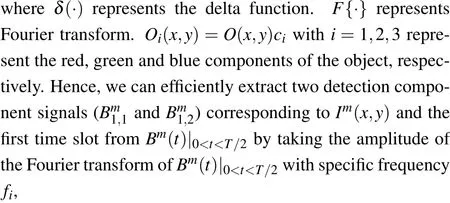

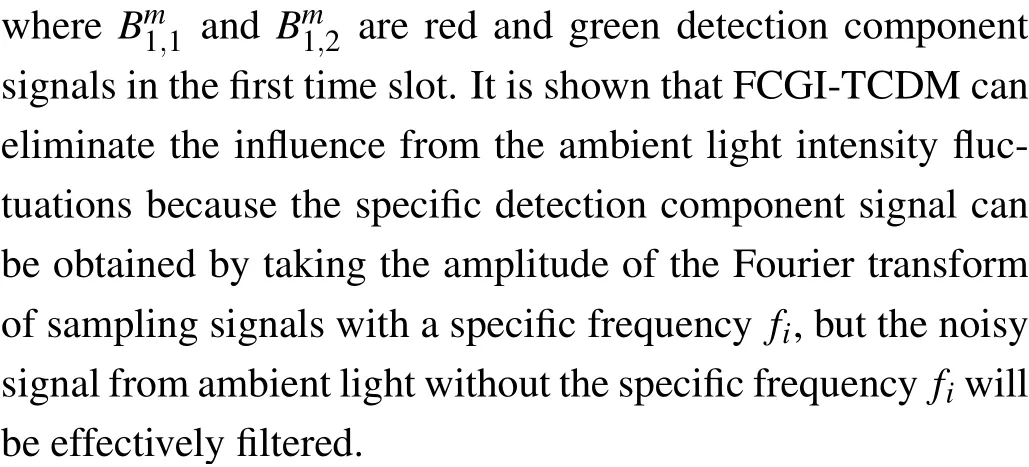

Fig.2. The schematic diagram of FCGI-TCDM reconstruction algorithm.


3. Results discussion
Figure 3 shows the experimental system of FCGI-TCDM.Three LED sources with specific color are modulated with two recurrent time slots(0<t <100 μs and 100 μs<t <200 μs,
whereT=200 μs) and two cosine waveforms with frequenciesf1andf2driven by an arbitrary waveform generator(AWG, RIGOL DG812), where the amplitude and the direct current offset of the modulated cosine waveforms are 3Vppand 3.5V,respectively. Then,the light from three LED sources is superposed by a beam splitter, and a speckle patternIm(x,y)is modulated onto the light by DMD(ViALUX V-7001). The speckle patterns transmitted by a TIR prism and a projecting lens are projected onto an object which is a transparent plastic thin sheet printed a colored image“fruits”. Subsequently the light from the object is measured by a photodetector (Thorlabs PDA100A2)and an analog-to-digital converter(NI PCIe-6374). Note that the black box in Fig. 3 shows that a white LED driven by a Gaussian random noise waveformn(t)is used as the noisy ambient light.In addition,we use mean square error(MSE)[5]to represent the difference between original imageO(x,y)and the reconstructed image ˆO(x,y)with the number of pixelsN,i.e.,MSE(1/N)∑x,y(ˆO(x,y)-O(x,y))2.
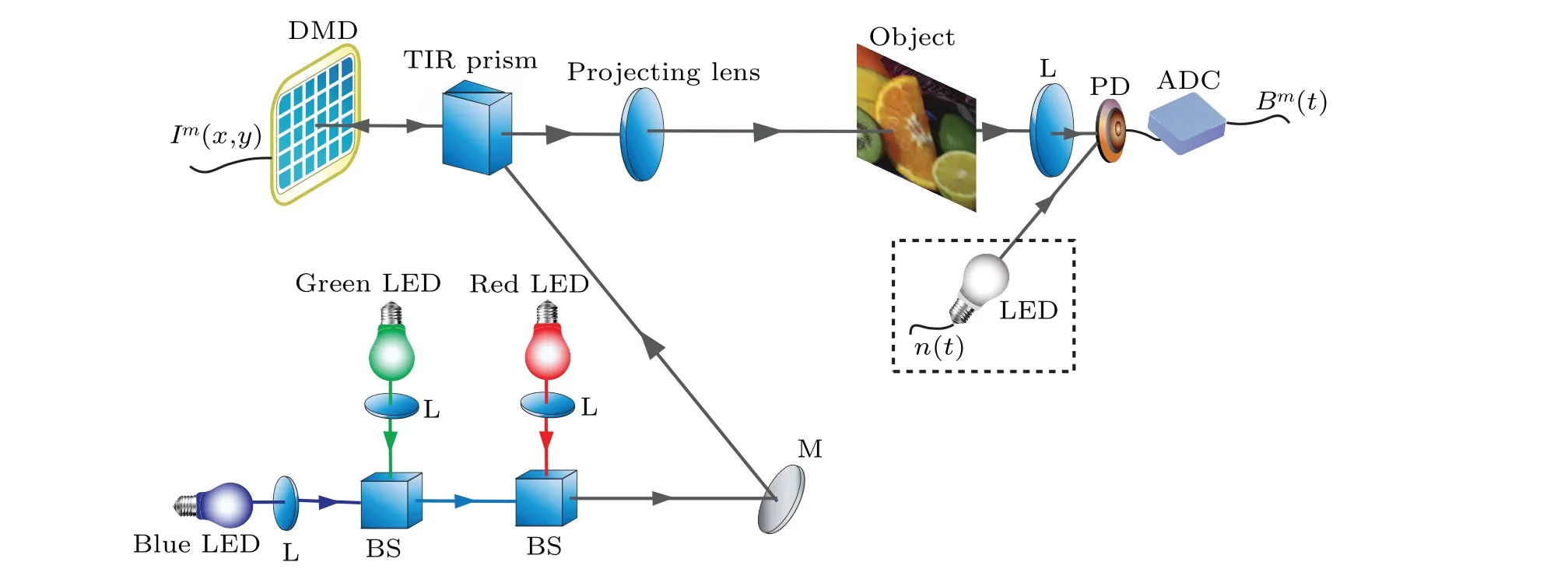
Fig.3. The experimental system of FCGI-TCDM.LED:light emitting diode. L:lens. M:mirror. PD:photodetector. BS:beam splitter. ADC:analog-to-digital converter. TIR:total internal reflection. DMD:digital mirror device.
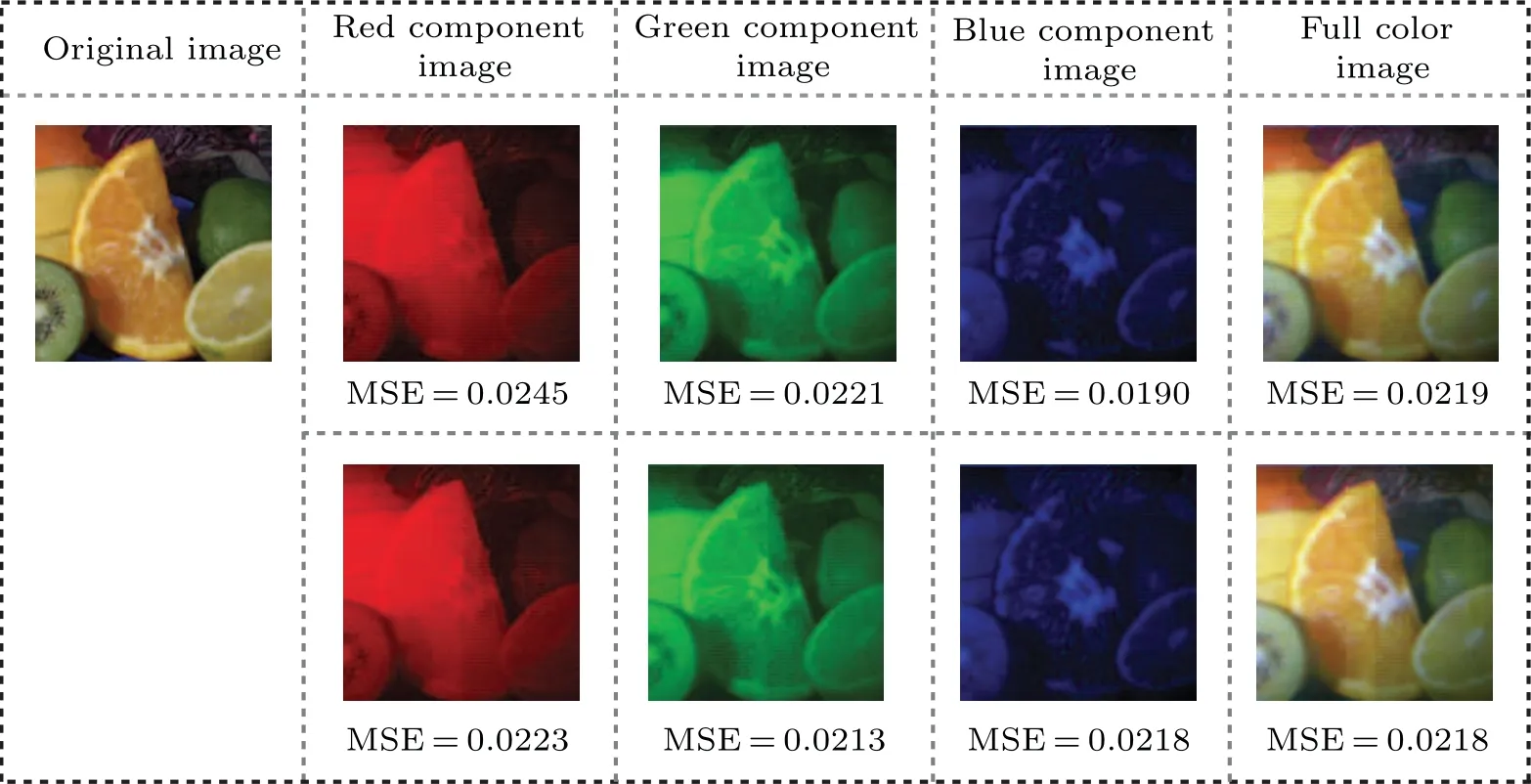
Fig.4. The experimental results of FCGI-TCDM.


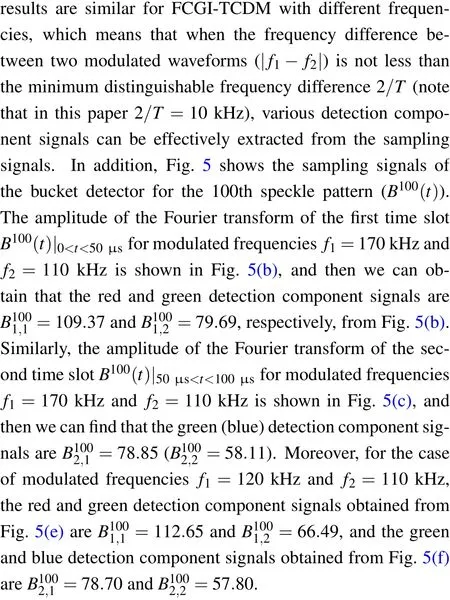
In addition,we compare the ability of robustness against the noisy signal resulting from the ambient light intensity fluctuations among FCGI-TCDM,FCGI-TDM and FCGI-MISO.For a fair comparison,FCGI-TDM uses the three colored LED sources in turn with time slot lengthT/3=66.7 μs to reconstruct the corresponding colored component images.In FCGIMISO,the sampling time for each speckle pattern is set up asT=200 μs and the frequencies of the cosine waveforms for red, green and blue LED sources are 170 kHz, 110 kHz, and 230 kHz, respectively. The modulated frequencies of FCGITCDM aref1=170 kHz andf2=110 kHz. Here an LED driven by a Gaussian random noise waveform from an AWG(bandwidth 1 kHz) is used to be an ambient light. The results shown in Figs.6, 7, and 8 demonstrate that the imaging quality of both FCGI-TCDM and FCGI-MISO will not decrease under the influence of ambient light. Even when the signal-to-noise ratio (SNR) is low, the imaging performance of both FCGI-TCDM and FCGI-MISO still does not deteriorate. The reason is that the specific colored component signal is obtained by taking the Fourier transform of the sampling signalBm(t) with a specific frequency, so these noisy signals without the specific frequency from the ambient light can be effectively filtered. Comparing to FCGI-MISO,FCGITCDM has the advantage that it can image the object with fewer number of codes because FCGI-MISO requires at least three cosine waveforms with different frequencies to achieve full color imaging,but only two cosine waveforms with different frequencies are used for FCGI-TCDM. The advantage of FCGI-TCDM compared to FCGI-MISO will be more significant when FCGI-TCDM is extended to multispectral GI with one bucket detector. In addition, the ambient light can obviously affect the imaging quality of FCGI-TDM. When SNR decreases,the imaging quality becomes worse and worse,and the reconstructed full color images become so blurred that one cannot see anything clearly for FCGI-TDM.
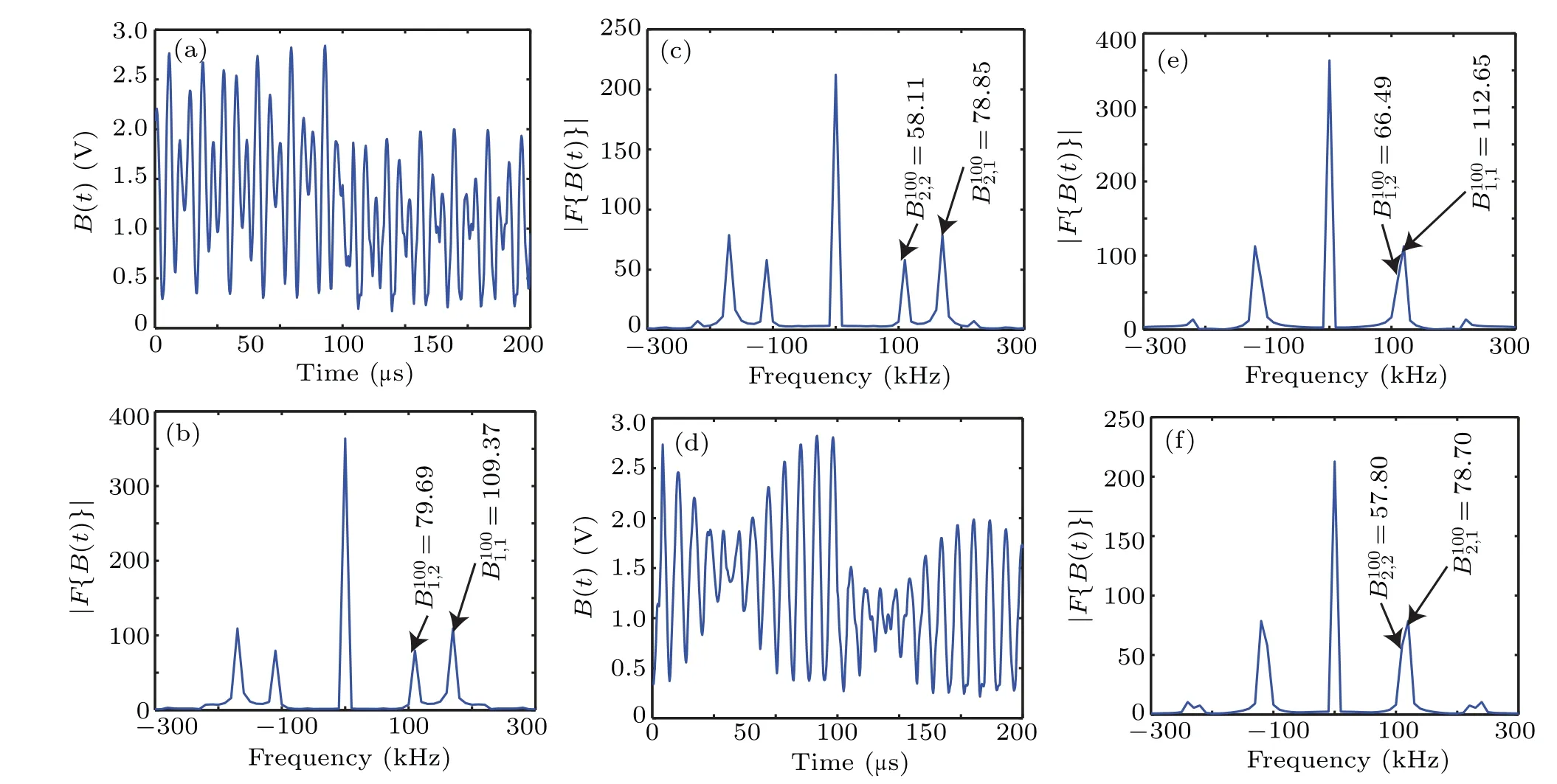
Fig.5. (a)and(d)The sampling signals of the bucket detector for the 100th speckle pattern B100(t)obtained by the photodetector in experiments. (b)and(e)The amplitude of the Fourier transform of the first time slot B100(t)|0<t<50 μs. (c)and(f)The amplitude of the Fourier transform of the second time slot B100(t)|50 μs<t<100 μs. Here,(a)–(c)give the results for f1=170 kHz and f2=110 kHz,and(d)–(f)show the results for f1=120 kHz and f2=110 kHz.

Fig.6. The experimental results by using FCGI-TCDM with the influence of the ambient light intensity fluctuations.

Fig.7. The experimental results by using FCGI-MISO with the influence of the ambient light intensity fluctuations.

Fig.8. The experimental results by using FCGI-TDM with the influence of the ambient light intensity fluctuations.
4. Conclusions
We have proposed a full color ghost imaging scheme using both time and code division multiplexing technologies,
where the speckle patterns of three colors(red,green and blue)are modulated with different time slots and codes.The light intensity is sampled by one bucket detector. Then we can effectively and simultaneously extract three detection component signals from the sampling signal of the bucket detector based on the modulated time slots and codes. Finally,three component images are used to synthesize a full color image, where three component images can be reconstructed separately with the detection component signals and speckle patterns.We have verified the feasibility of our scheme under the limit of the number of time slots and codes by experiments. Moreover,our scheme has the advantages of the decrease of the number of bucket detectors and can realize high quality imaging even in a noisy environment.
Acknowledgements
Project supported by the National Natural Science Foundation of China (Grant Nos. 62001249 and 61871234), the NUPTSF(Grant No.NY220004),and the Scientific Research Project of College of Information Engineering, Fuyang Normal University(Grant No.FXG2021ZZ02).
- Chinese Physics B的其它文章
- A design of resonant cavity with an improved coupling-adjusting mechanism for the W-band EPR spectrometer
- Photoreflectance system based on vacuum ultraviolet laser at 177.3 nm
- Topological photonic states in gyromagnetic photonic crystals:Physics,properties,and applications
- Structure of continuous matrix product operator for transverse field Ising model: An analytic and numerical study
- Riemann–Hilbert approach and N double-pole solutions for a nonlinear Schr¨odinger-type equation
- Diffusion dynamics in branched spherical structure

